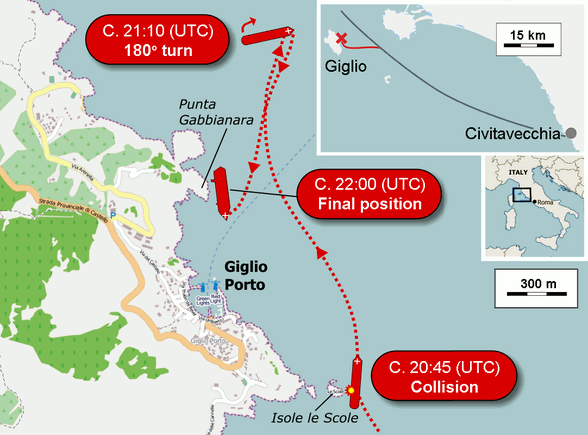Costa Concordia
© Charles ChandlerIn all of the media coverage of the sinking of the Costa Concordia, the one detail that has been barely mentioned is the exact cause of the tragedy.The general context is well-known.
- The captain ordered a "sail-by" that brought the ship close to an island.
- When he saw waves breaking on the rocks and realized how close he was to shore, he ordered a course change to avoid running aground.
- The order came too late, and the rocks tore a 50 meter gash in the ship's port side, below the waterline.
- The interior of a modern ship is divided into watertight compartments. If one is flooded, it is simply sealed off, such that the water cannot flood the other compartments, and the ship is still seaworthy. But if several or many compartments are breached, the ship can sink.
- The 50 meter gash breached several compartments, and the ship sank.
Figure 1. Rock embedded in the port side of the damaged hull, very near the stern of the Costa Concordia. Photo courtesy Rvongher.The detail that has been neglected is that it was the exaggerated attempt to avoid the collision that actually caused the collision. Ships are turned from the stern, where the rudder is. A hard turn to the right kicks the stern of the ship to the left. In a close-quarters situation, this can cause a collision that might not have occurred otherwise. If the bow clears the obstacle, and if the ship is going straight, the rest of the ship will clear the obstacle as well, since the stern is not wider than the bow. But if the ship is in a hard turn, the swing of the stern might bring it into contact with the obstacle. Since the damage to the Costa Concordia was near the stern, it was caused by the turn itself. (In other words, it's just like driving a forklift, which is also steered from the back. If the front of the forklift clears an obstacle, but you're still too close, you don't turn away from the obstacle — you turn into it, to get more clearance.)Figure 2. Course of the Costa Concordia, 2012-01-13, courtesy J. J. Hornung, showing the turning maneuver that caused the collision.Captain Francesco Schettino said as much to the magistrates investigating the accident.1"I may have done something rash, I did do something rash, but God would have made it alright for me if I hadn't set the rudder to starboard."In short, the captain lacked basic helmsmanship skills, and that's what actually caused the collision.Unfortunately, this kind of "side-swiping" is actually worse than a head-on collision. As the ship scrapes along the obstacle, many compartments can be breached, possibly sinking the ship. In contrast, a head-on collision might only breach one compartment (i.e., the bow section), and there is less chance of taking on more water than the ship can handle.This, by the way, was the same mistake that sank the Titanic, which also suffered damage that began behind the bow section, meaning that the bow had already cleared the obstacle. The rest of the ship would have cleared it too, had they not tried to turn away from the iceberg. The side-swiping collision breached 5 compartments, while the ship could not stay afloat if more than 4 compartments were flooded. Other problems have been cited in the Titanic disaster, such as steel that was more brittle in cold water, and the fallibility of rivet construction. Now ships use higher-quality steel, with welded joints.Yet even in calm, warm seas, a well-built ship such as the Costa Concordia isn't going to stay afloat if the captain attempts a close-quarters maneuver without knowing which end of the ship does the turning.Figure 3. An accurate map of the Costa Concordia's course, courtesy Qastor Pilotage. As of the last red position, the proper wheel command would have been hard to port, knowing that it wouldn't change the position of the bow, but it would afford more clearance at the stern. Instead, the wheel was thrown hard to starboard, kicking the stern into the rocks.
References
1. Viggiano, L.; Mackenzie, J. (2012): Newsmaker: Captain at centre of Italy cruise ship disaster. Reuters ⇧













